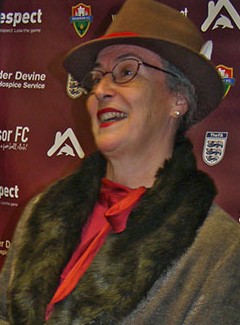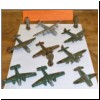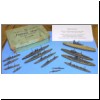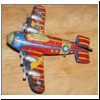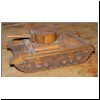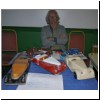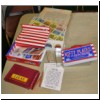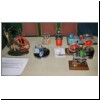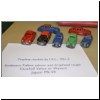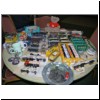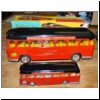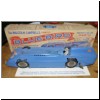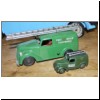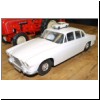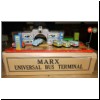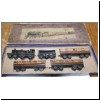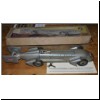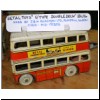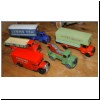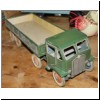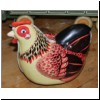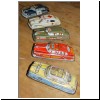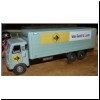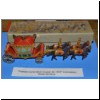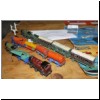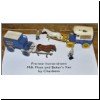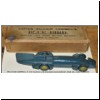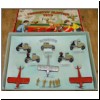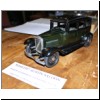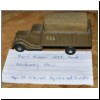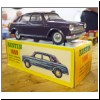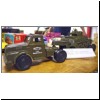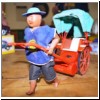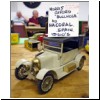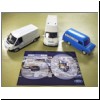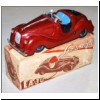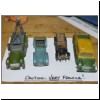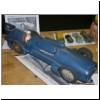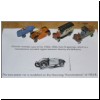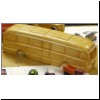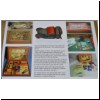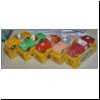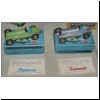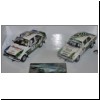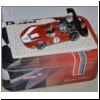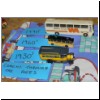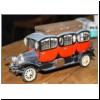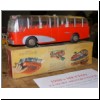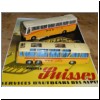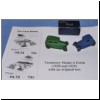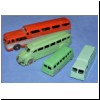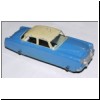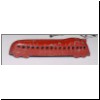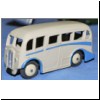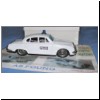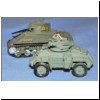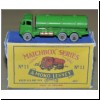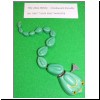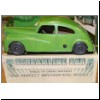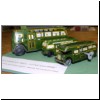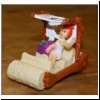| home page |
latest news | news
archive 2016 |
news
archive 2014 |
news
archive 2003-2010 |
|
Click
on a thumbnail to
enlarge
OCTOBER 2015
Click
on a thumbnail to
enlarge
The October clubnight gave
members a chance to show off some of their interests, whether static
model related or not. Neil Baldry showed us his collection of the
Codeg ‘sports car’ which he has deduced is based on a Citroen Traction
Avant 11B with bodywork by French coachbuilder Robert de Clabot.
Codeg was the brand name of London wholesalers and importers Cowan de
Groot Ltd. John Harrison had an international collection of car
number plate recognition games from the UK, the USA and Germany. There
was also an impressive display of stationary Stirling engines, and
Robert Newson showed a selection of tinplate models by IXL, a
manufacturer about which little information seems to exist. The
four IXL cars were a Vauxhall Velox, a Mk7 Jaguar, and Sunbeam Talbots
in saloon and drophead versions. Adrian Levano had a display
related to Cologne, a city which he knows very well, and which yields
quite a good number of models. The 4711 brand of Eau de Cologne is
known worldwide, but the many brands of Kölsch beer are more of a
local delicacy. Cologne is also known as the base for the German
Ford works, and the Stollwerck chocolate brand which has a Chocolate
Museum in the city – a popular tourist attraction on the banks of the
Rhine. The Prämeta model company was also from Cologne,
their clockwork cars being marked ‘Made in Germany, British Zone’ on
the base. The famous cathedral features on many of the tourist
souvenirs, even on the T-shirt of the bear who was borrowed for the
evening!
The competition was ‘Little and Large’ – two models of the same vehicle in different scales, won by a pair of Midland Red Motorway Coaches, Corgi and Guiterman, belonging to Derek Boxall. Second were a pair of 1935 Bluebirds from Geoff Holden – a tinplate clockwork contemporary model, possibly by Betal, and a 1963 plastic cereal packet toy from Kellogg’s. Third were the Post Office Telephones vans entered by Neil Baldry, by Dinky and Mettoy. A pair of Jaguars XJs from Michael Driver were in fourth place.
Click
on a thumbnail to
enlarge
SEPTEMBER 2015September clubnight was
fish and chips night, and John Garside entertained us with a quiz
designed to show up our general ignorance, although there was
inventiveness too, with some alternative answers.
The competition was Lithographed Tinplate Models and first prize went to Michael Driver for an art deco style Marx ‘Universal Bus Terminal’. Second place went to Clive Gehle’s Bing train, with Geoff Holden’s 1929 Silver Bullet by Günthermann third. Fourth place went to Ian Cook’s Betal Q Type bus. A selection of the other tinplate entries are shown in the second row of photos.
Click
on a thumbnail to
enlarge
AUGUST 2015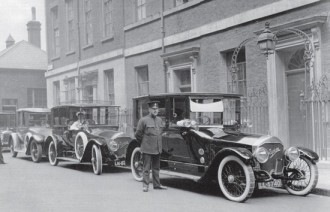 At
the August clubnight, Alan Vessey give an interesting and
well-illustrated talk on the Napier company, from its foundation in the
early 19th century through to being absorbed into Rolls-Royce in the
1960s. Although less well-known
than Rolls-Royce, Napier surely deserves a more
prominent place in the consciousness of transport connoisseurs because
of their engineering achievements
in motor sport and land speed record breaking, plus their success in
the aero engine field. At
the August clubnight, Alan Vessey give an interesting and
well-illustrated talk on the Napier company, from its foundation in the
early 19th century through to being absorbed into Rolls-Royce in the
1960s. Although less well-known
than Rolls-Royce, Napier surely deserves a more
prominent place in the consciousness of transport connoisseurs because
of their engineering achievements
in motor sport and land speed record breaking, plus their success in
the aero engine field.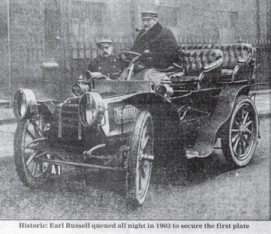 The photos show a line-up of
Napier ministerial cars outside 10 Downing Street and a Napier which
received the very first registration plate, A1, in 1903. Supermarine planes with
Napier engines were twice victorious in the Schneider Trophy, and after
the war their engines saw service with the navies of many nations – and
in the Deltic class of locomotives which were named after the Napier
engines which powered them. The photos show a line-up of
Napier ministerial cars outside 10 Downing Street and a Napier which
received the very first registration plate, A1, in 1903. Supermarine planes with
Napier engines were twice victorious in the Schneider Trophy, and after
the war their engines saw service with the navies of many nations – and
in the Deltic class of locomotives which were named after the Napier
engines which powered them.In the competition on the theme of pre-war models, first prize was awarded to Hilary Gatward for a 1937 Wells-Brimtoy Coronation Coach. Second was a collection of Dinky trains from Clive Gehle, and third prize went to Robert Newson’s pair of horse-drawn vehicles by Charbens – a baker’s van and a milk float. Fourth was Geoff Holden’s Johillco Bluebird, as driven by Malcolm Campbell, which had a Napier Lion engine. Other entries in the competition which caught our eye were the Tootsietoy ‘Aerial Defense’ set, a Ranlite Austin saloon, and an American Barr Rubber Ford truck.
Click
on a thumbnail to
enlarge.
JULY 2015At the July clubnight,
Peter Parry gave a presentation about Remap, a charity which
concentrates on providing what are often one-off solutions to problems
faced by people with disabilities, or by anyone having problems with
the day-to-day tasks most of us take for granted. We heard of several
of the ingenious inventions, inspired by the engineering
and practical backgrounds of the 1,000 or so volunteers. These
range in complexity from the simple expedient of gluing two clothes
pegs together for someone with one arm, to applications using aircraft
hydraulic components. Remap spends a very small
proportion of its funds on administration (unlike some of the major
charities) and has a network of 90 local groups. They are always
looking for supplies of surplus engineering materials – but also use a
3D printer to produce components which would otherwise be outsourced
for manufacture at a far higher cost, and we saw the printer in action
building up layers to create a plastic part. The recipients of the
charity’s efforts experience a real difference in their lives,
and the volunteers (many of whom are retired engineers) benefit
from the process of problem-solving, as it keeps their grey cells
active!
The competition entitled ‘plastic model vehicles’ produced a colourful display and the winners were as follows. First prize went to Roy Ellison for the Austin 1800 ‘Land Crab’, second to Hilary Gatward for a Mettoy tank transporter with its load, third to George Hatt for a Rickshaw complete with chinaman, and fourth to Ian Cook for a Nacoral Bullnose Morris which was found in a skip! A couple of additional entries are shown in the photos. Fifty years of the Ford Transit were celebrated with a trio of models. You may not know that the Transit name had been used by Ford Germany since 1953, long before the first-generation Transit appeared in the UK. The ‘Ca-Ju Sportmodell’ was developed shortly after the war by Max Carl and his son in East Germany, who were previously manufacturers of mechanical toy animals. They abandoned the benefits of the socialist state for the decadent west in 1952/3 so this item probably dates from before then as the name, which seems to be an abbreviation of Carl and Son, was not used by the nationalised company.
Click
on a thumbnail to
enlarge.
JUNE 2015Although the trading tables
evening in June was announced at fairly short notice, there was a good
turnout, a good number of interesting items were available, and quite a
few ‘deals’ were done!
The competition was on the theme of wooden models of road vehicles – maybe not something we think of as a major material for items in our collections, but a varied selection appeared on the competition table. Although wood is perhaps not so well-suited to mass production as diecasting or injection moulding, it was historically a major component in toy manufacture, and in certain areas remains so to this day. First prize went to Bob Pitkin for a display of ‘very fragile’ hand-made models which were rescued from Dave Robinson’s workshop. Second was a large Bluebird from Geoff Holden, with third prize going to Robert Newson for a selection of 1920s-1930s German wooden toys from the Erzgebirge region. The two-seater car is based on the Hanomag Kommissbrot. In fourth place was a nicely detailed coach from George Hatt. An additional ‘highly commended’ mention went to Adrian Levano for another German pre-war item, this from Schowanek.
Click
on a thumbnail to
enlarge.
MAY 2015At this month's Scalextric
night, the knockout competition gave us all a chance to show our racing
skills – or lack of them! Some discussion was to be heard about
the relative merits of the two supposedly equal cars, but in the end
the winner was Bob Collins who took away a bottle of fizz.
Fortunately he did not share it with the crowd in Formula One fashion!
Also set up were a Marx speedway track and a 1968 Matchbox Superfast track. In a fairly non-scientific study, it was decided that the very first Matchbox Superfast cars with narrow wheels are a match for most of the competition, although Corgi Rockets also performed well. In the ‘Competition Cars’ competition, first place went to Michael Driver for a display of boxed Dinky sports cars. Second went to Gary Maslin for a pair of boxed Scamold racing cars (a Maserati and an ERA) complete with original Autocar advertising slips. Third, appropriately for the main event (even if not for the name of the club), was George Bennett’s pair of Scalextric Ford Escorts, Mk.1 and Mk.2, in Eddie Stobart livery. Fourth was a Sloter Lola belonging to Allan Feldman.
Click
on a thumbnail to
enlarge.
APRIL 2015At the well-attended April
clubnight we were treated to a very interesting evening in the company
of Mervyn Annetts. He started by giving us a run-down of the
history of coaching from the horse-drawn days, through the impact of
railways, to the modern era.
Mervyn also told us his own story, including his apprenticeship at Thornycroft which led to his interest in Thornycroft Antars, of which he has owned more than one. However, it was his experience in the coach business which was the main focus. Having worked for Porters, he went on to operate his own Bedford OB, HOD 75, which he still owns, and which has appeared in numerous films and TV shows, as well as serving as the inspiration for three models, two by Corgi and the 1:24 Sunstar. His company, Mervyn’s Coaches, expanded to include modern vehicles – the fleet starting mainly with more modern Bedfords, then later changing to Volvos. The OB, which has now been in the fleet for 35 years, still earns its living on special charters but has more recently been joined in that role by a 1937 11-seat Bedford WS. There is also an AEC Regent, currently a restoration project, which is set to join the heritage fleet at some point. Mervyn brought a selection of his own models to display as well as some other coach-related items. The competition (which
Mervyn judged) was on the theme of coaches and
attracted a good entry. First prize went to Gordon Kingsbury for
‘Coaches Through the Ages’ including a Rio (actually 1915, not 1930s!),
an EFE Harrington Grenadier in Wimpey livery, and a Joal model of a
Wallace Arnold coach. Second prize went to an unusual Safir 1:43
model of a 1910 Gregoire which looked as if it consists of three old
horse-drawn coach bodies joined together. This belongs to Bob
Westerbeke.
Third was Gary Maslin’s boxed Mettoy Coach, with fourth place going to Adrian Levano for a pair of Swiss Post Buses; another incarnation of the Joal coach along with a Dinky VAL. The poster on which the PTT buses were displayed features another 6-wheel coach, but with four at the back.
Click
on a thumbnail to
enlarge.
MARCH 2015March 16th was the Annual General meeting of the MSMC. This was also the night for the annual presentation of the club trophies, as follows:
FEBRUARY 2015At the February clubnight
Jim Lindsay gave us a very interesting appraisal of the ups and downs
of Tootsietoy, with reference to other American manufacturers. He
talked about the pros and cons of toy manufacturers having
relationships with real vehicle makers and the ways in which copyright
restrictions were sometimes avoided. In terms of marketing, the
more accurate models would often appeal to the parents, or could be
used by salesmen to promote their cars through the children – on the
other hand, generic models did not go out of date every year (unlike
their real counterparts). From some very innovative and accurate
models in the early 1930s, he showed examples of the decline in
accuracy and cost-cutting in later years. However, even the
Graham series of models, made to tie in with the manufacturer, included
some flights of fancy! The common chassis allowed for commercial
variants that never existed in real life.
As well as a competition on the Tootsietoy theme, we also had the ‘Kit, Chop and Restoration’ competition. The winner among the Tootsietoys was a pair of Ford Model A saloons with an original box from Robert Newson, followed in second place by a group of buses from Michael Driver. Third was a blue and cream Mercury saloon from Brian Gatward, and in fourth place a tiny Zephyr Railcar from Clive Gehle. The ‘Chop’ winner was Paul Rowley with a shortened Dinky coach, the ‘Restoration’ prize went to Ian Cook for a Jaguar Police car, and the ‘Kit’ winner was Derek Boxall's pair of military vehicles.
Click
on a thumbnail to
enlarge.
JANUARY 2015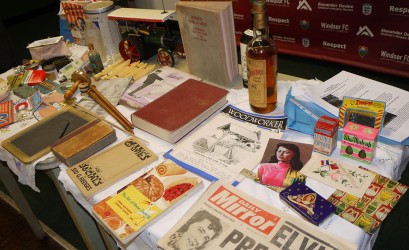 In
January we heard a very interesting account of Milestones Museum –
‘Hampshire’s living history museum’. In
January we heard a very interesting account of Milestones Museum –
‘Hampshire’s living history museum’.Built to house a collection of artefacts from the local area (including vehicles from the Thornycroft collection) the museum presents a re-creation of typical street scenes to take you back in time. We heard about the long process from the decision to build until completion, the 85,000 tonnes of chalk that were dug out (yielding a collection of fossils for the museum!) and the construction process that eventually allowed the museum to open in November 2000. To add to the realism ‘costumed interpreters’ help to deliver the message about the differences in the way we live now compared to the past, and we heard many of the amusing anecdotes arising from exchanges with the public. Quite a few of these were with children – a major focus of the museum’s work is to provide schools with a way for their pupils to interact with history. A special relevance is provided by the museum’s collection of locally produced items, and the museum is a means for the local authority to fulfil its legal requirement to conserve local artefacts. One interesting aspect of the Thornycroft company was an enlightened approach to women-friendly employment. It was also the first industrial company in Basingstoke to provide hot meals in its canteen. Some of the smaller items from the museum’s collection were on display, covering the period from 1820 to 1977. The competition was ‘Green Toys’, and the results included a ‘highly commended’ in addition to the usual four winning entries. First was a Matchbox tanker belonging to Ian Cook. Second was a Tri-ang Loch Ness monster belonging to Hilary Gatward. Third was a Mettoy limousine entered by Gary Maslin, with Brian Gatward’s Wells Brimtoy buses in fourth place. Neil Baldry’s Flintmobile gained the ‘highly commended’ honour.
Click
on a thumbnail to
enlarge.
|
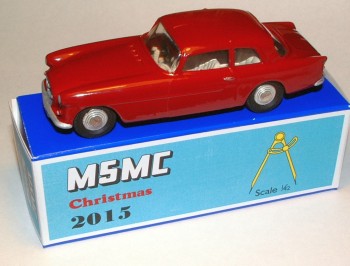
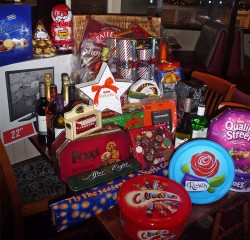 and as in previous years
this was held at the Toby Carvery in Old Windsor. The highlights of
the evening were the prize draw with its many prizes – and at the
conclusion of the evening the distribution of the annual Christmas
model. This year the model was a Bristol 406 (click on the
picture for more details).
and as in previous years
this was held at the Toby Carvery in Old Windsor. The highlights of
the evening were the prize draw with its many prizes – and at the
conclusion of the evening the distribution of the annual Christmas
model. This year the model was a Bristol 406 (click on the
picture for more details).